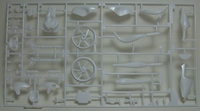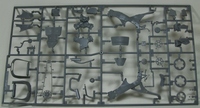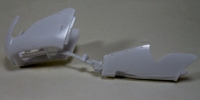Hasegawa 2002 Honda NSR250 "Team Spain' No1 Honda Gresini"
By Jon Fincher
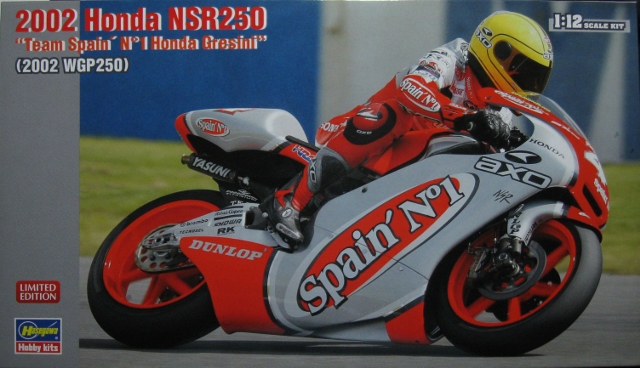
This bike is an odd choice for a kit, as it doesn't seem to have any major wins or major riders associated with it. The 2002 season was dominated by Aprilia, who won 14 of 16 races with riders Marco Melandri and Fonsi Nieto taking first and second that year. Team Gresini had a two 250cc riders in 2002, Roberto Rolfo and Emilio Alzamora, who placed third and seventh respectively. Both riders left MotoGP shortly after this season, with Rolfo moving to Superbike and Alzamora leaving the sport entirely. Notably, Alzamora's sole claim to fame is having won the 1999 125cc championship without ever having won a race that year. This kit can be built up into either Rolfo's or Alzamora's bike - you can pick whichever non-winner you want to represent.
Opening the Box
As with the previous preview model, Hasegawa molded the bike in grey and white, with a clear sprue for the windshield and, oddly enough, the wheels for the bike stand. Separately bagged tires, hoses, and other hardware complete the kit - no clear body panels were present in my kit, and oddly no screwdriver for the long bolts which hold the wheels on. And as before, there is no chrome in the kit - builders will have to provide their own metallics as they build, and protect them from wear and tear from handling as they work.Inspection
This kit is typical Hasegawa quality - crisply molded, little to no flash, and well defined detail. The engine is nicely detailed and should respond extremely well to brush painting. The frame does not capture the engine, and so it can be completely painted and detailed on it's own. Hoses and other hardware provided will also add to the realism of this kit.However, there are some things which stood out as challenges. Weld lines on the frame have no weld detail - they're just raised lines. There are ejector pin marks on the front and rear brake rotors which will be difficult to remove without removing other detail. The chain has seven sprue attachment points, and another nine injection channels attached to it which will require cleanup - on such a fragile part, this will require care. As with the previous kit, bolts which hold the engine in place are injected parts with the sprue attachment on the visible bolt head.
Instructions and Decals
The ten page instruction sheet is well detailed, and provided plenty of good quality images to guide the builder. Information on the bike, riders, and the racing team is accurate and helpful. Paint colors are provided with GSI Creos and Mr. Color, and as before, I recommend https://www.ipmsstockholm.org/colorcharts/stuff_eng_colorcharts_gunze.htm for color conversions. TIP: For easy reference, I write out my color conversion chart for each model on a separate sheet of paper, and keep it with the kit so I don't need to flip back and forth in the instructions all the time.
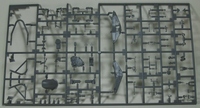
The decals are very high quality, with minimal carrier film and very good color. Numbers for both Rolfo and Alzamora are given, and a full set of logos, sponsor decals, and paint details are provided. However, these extra details will require planning so they don't cause more problem down the road.
Planning the Build
As with most racing motorcycle kits, the body work is what differentiates one kit from another. And it's in the finish that the most planning needs to be done. Looking at the decals, I noticed some potentially big problems.
The large Spain'No1 decal spans the upper and lower body panels, and will need some care to get placed correctly. However, this is child's play for the experienced modeler,and having met that challenge, the builder will need to address the next one.The main color of the bike is day-glo or flourescent red, which is approximated in the Spain No.1 decals. This color will need to be matched on the tank, front cowl, rear part of the underbelly, and the wheels, lest the bike appear to have been painted by different people on different days. Even this can be overcome with a little effort, but once that foe is vanquished, the builder must yet confront another, deadlier adversary looming on the horizon.
The body is two-tone, silver and day-glo red, with decals marking the transition between them. From my previous build of the 2009 RS250RW, I know that finding the right place to make the color transition so it can be covered properly by the decal is difficult. In my previous attempt, I tried using photocopies of the decals to locate the color transition for masking, but was not always 100 percent successful. In trying to clean up colors and decal placement, I found that the silver paint did not allow the decals to adhere properly, so masking after clear-coating lifted them. Addressing this challenge will require some planning on the part of the builder.Overall
The kit is high quality which is typical Hasegawa, and varies only slightly from other racing motorcycle kits they have offered. For the most part, the detail is crisp and even, with some minor issues to rectify as the build progress. The main challenges will lie with the finish, primarily with color selection and decal placement. While an odd selection for a subject, it's one I look forward to building and displaying - I am eager to apply my learnings from the RS250RW kit, and prove to myself and the rest of the world that I can build this kit.My thanks to Hasegawa USA for this review sample.

